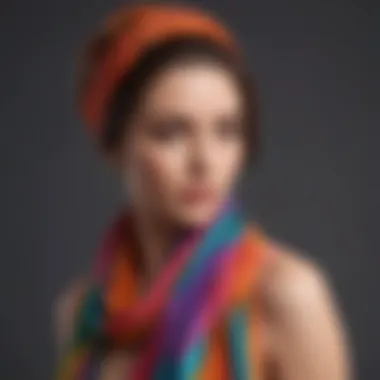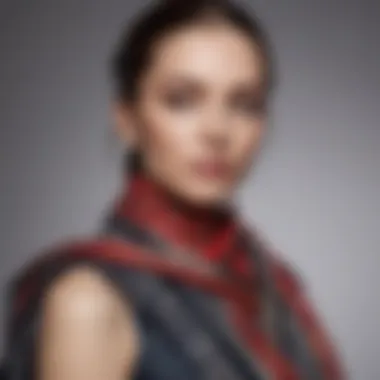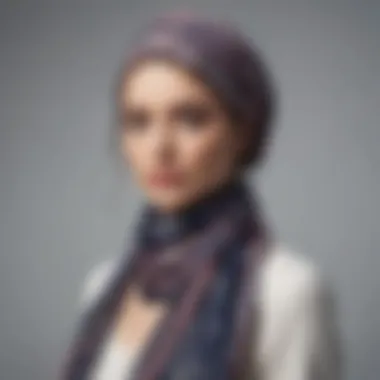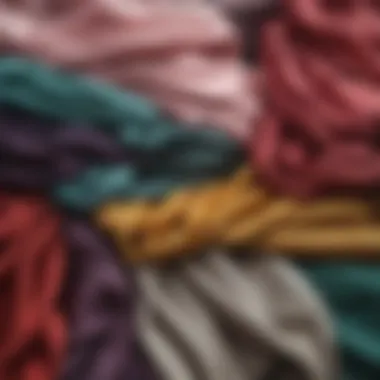Scarves for Hair Wrapping: A Comprehensive Guide


Intro
Scarves have long been a versatile accessory in the world of fashion. They not only enhance the overall look but also serve practical purposes. One such purpose is hair wrapping, a technique that combines tradition with modern styling. This article explores the various aspects of using scarves for hair wrapping. We will look into the easiest methods, different types of scarves that suit this purpose, and how to add them to your personal style.
Hair wrapping has cultural significance in many societies. It can signify status, heritage, or even simply serve as an everyday styling tool. The appeal of wrapping hair extends beyond these cultural dimensions; it offers numerous benefits, including hair protection and versatility in styling.
As we explore this subject, we will offer a detailed examination of current fashion trends related to hair wrapping, practical beauty tips for incorporating this into your routine, and insights on popular products designed for this purpose. Below, we dive into fashion trends that have a powerful influence on how women of all ages use scarves for hair wrapping.
Foreword to Hair Wrapping with Scarves
Hair wrapping with scarves has gained recognition as not just a utilitarian practice but also an important component of cultural expression and personal style. The act of using a scarf to wrap hair goes beyond mere aesthetics, playing a significant role in protecting hairstyles and promoting hair health. It has roots in various cultures, reflecting diverse traditions and practices.
This guide aims to explore the multifaceted aspects of hair wrapping with scarves. It will delve into understanding the art of wrapping hair, the historical significance behind the use of scarves, and the benefits one can reap from incorporating this practice into their routine.
Understanding Hair Wrapping
Hair wrapping is a technique employed to protect hair from damage and maintain the integrity of various hairstyles. It involves wrapping a fabric, such as a scarf, around the head to secure the hair in place. This practice is particularly beneficial for those with textured or curly hair, as it helps to minimize friction and breakage while preserving moisture and style.
The method not only serves a practical purpose but also allows for creativity. It offers an opportunity for individuals to express themselves through different tying techniques and patterns. By experimenting with various types of scarves and styles, one can create a unique look that complements their personal fashion.
Historical Context of Hair Scarves
Historically, hair scarves have been utilized across cultures for centuries. From the vibrant head wraps of Africa to the elegant silk scarves worn by women in Western societies, each culture has its unique significance attached to hair wrapping.
In many African communities, head wraps—often referred to as "gele" or "duku"—symbolize identity, status, and motherhood. They have been used as a form of self-expression for generations.
On the other hand, in European and other cultures, scarves have often served practical purposes, such as keeping hair neat and tidy in various settings. The scarves’ styles may vary, illustrating different trends throughout history.
The evolution of hair scarves is not just about fashion, but it also reflects broader social changes. Over time, hair wrapping has become a way for individuals to reclaim their heritage and authenticity, merging past traditions with contemporary styles.
Understanding the historical context enriches the practice of hair wrapping today, as it acknowledges the diverse origins and meanings that scarves hold in various societies.
The Benefits of Using Scarves for Hair Wrapping
Hair wrapping with scarves provides multifaceted benefits that go beyond mere aesthetics. Utilizing scarves for this purpose serves as a means of prolonging hairstyles, ensuring hair health, and even making a style statement. This section presents a detailed exploration of the various advantages that come from using scarves to wrap hair, thereby illustrating their importance in your hair care routine.
Hair Protection and Health
Wraping hair with scarves acts as a protective barrier that shields hair from environmental damage. This can include exposure to sunlight, pollution, and harsh weather conditions. For individuals with curly, coiled, or textured hair, protection is particularly crucial as these hair types are often more susceptible to breakage and dryness. Scarves create a secure environment, reducing friction between hair strands and external factors, which helps in minimizing split ends and frizz.
Additionally, wrapping hair can lock in moisture. When paired with moisturizing products, scarves can help maintain hydration levels, leading to healthier hair overall. This practice is especially valuable during colder months when natural moisture can evaporate quickly.


Protecting your hair should not be an afterthought. Make scarves a part of your daily hair routine for optimal health.
Aesthetic Enhancement
Scarves offer an opportunity for personal expression. By selecting different colors, patterns, and materials, individuals can tailor their look to reflect personal style. This versatility allows for creativity in styling while also enhancing the overall appearance. A well-chosen scarf can transform a casual outfit into something more polished or can serve as a statement piece that draws attention.
Furthermore, hair wrapping can serve as a way to maintain a hairstyle for longer durations. Whether it's to preserve curls or prevent frizz during sleep, a scarf provides a visual charm while keeping hair intact. The practicality combined with the visual appeal makes scarves an integral accessory in many wardrobes.
Versatility and Convenience
Scarves are not only functional but also incredibly versatile. They can be wrapped in various styles, adapting to different looks and occasions. From simple knot techniques to more intricate braids, the options are limitless. This adaptability means that individuals can easily switch up their look as needed, making scarves a convenient accessory for those who value flexibility in their appearance.
In addition, using scarves is also a time-effective solution. Many Hair styles can take considerable time to set. However, with a scarf, one can quickly wrap hair and be on their way, saving precious minutes during busy mornings or when preparing for an event. The practicality of using scarves extends to their affordability as well, with a wide range available across different price points, making them accessible for most.
Types of Scarves Suitable for Hair Wrapping
Understanding the types of scarves suitable for hair wrapping is important for achieving both functionality and style. Scarves come in various materials, sizes, and designs, each influencing how they work for wrapping hair. The right scarf can protect hair from damage while also enhancing one's overall appearance. When selecting a scarf, considerations should include the fabric's texture, breathability, and weight. Each type of scarf offers distinct benefits, making it essential to choose wisely based on personal preferences and needs.
Silk Scarves
Silk scarves are renowned for their softness and smoothness. The luxurious texture glides over the hair, reducing friction and potential breakage. Additionally, silk’s natural temperature-regulating properties help maintain moisture in the hair. This is particularly advantageous for those with curly or textured hair, as it prevents dryness and frizz. When wrapping with a silk scarf, one can achieve a sleek finish. The weight of silk is also lightweight, making it comfortable to wear for extended periods. However, silk requires careful handling, as it can be prone to stains and damages.
Cotton Scarves
Cotton scarves are a staple in hair wrapping. They are breathable, which ensures comfort, especially in warmer climates. Cotton absorbs moisture effectively, helping to keep hair fresh. This is important for maintaining scalp health. The versatility of cotton allows for various styles and knotting techniques. It’s also generally more durable and easy to clean compared to silk. However, pure cotton may lack the slip that silky fabrics provide, which can lead to tangling. To mitigate this, many choose a cotton blend that incorporates some synthetic fibers for enhanced manageability.
Satin Scarves
Satin scarves offer a middle ground between silk and cotton, combining the smooth texture of silk with the durability of cotton. They are less expensive than silk, and their sheen adds a touch of elegance. Satin helps in minimizing friction, thereby preventing hair breakage and promoting a healthy shine. They’re easy to tie and hold in place, making them ideal for a variety of hair lengths and styles. While satin can be more affordable, it is essential to check the fabric content, as some may be made from synthetic materials that do not provide the same benefits as natural fibers.
Knitted and Crochet Scarves
Knitted and crochet scarves present a unique option for hair wrapping, especially in colder climates. These scarves offer warmth and can protect hair from harsh weather elements. The texture may vary, providing different levels of grip which can be useful for holding hair in place. However, they may not offer the same smooth effect as silk or satin. When choosing knitted or crochet options, ensure they are made from hypoallergenic materials to avoid irritation. Their styling possibilities are vast, offering an opportunity for personal expression through various patterns and colors, making them not only functional but also fashionable.
Techniques for Effective Hair Wrapping
Hair wrapping is more than just a practical approach to managing hair. It is an art form that requires technique and attention to detail. In this section, we will explore the various methods of hair wrapping using scarves. Understanding these techniques is vital for anyone looking to protect their hair or maintain a chosen aesthetic. Effective hair wrapping can prevent breakage, keep hairstyles fresh, and highlight personal style.
Basic Wrap Styles
Basic wrap styles are essential for beginners. They provide a foundation for the more complex techniques that follow. One popular style is the simple turban wrap. To achieve this look, begin with a rectangle scarf. Fold it in half to form a triangle. Place the long edge across your forehead, letting the two points hang down behind your neck. Bring the two points together and tie them securely. Adjust the fabric for comfort and ensure the wrap is snug but not overly tight.
Another effective basic style is the bun wrap. For this style, pull your hair into a bun and secure it with a hair tie. Take a square scarf, and place it under the bun. Cross the ends over the top and tie them at the base of the bun. This look keeps the bun secure while adding a stylish twist to an everyday hairstyle.


Advanced Wrapping Techniques
Once you have mastered basic styles, you can advance to more sophisticated techniques. One such technique is the double wrap, which adds extra layers of fabric and a unique silhouette. Start with two scarves—one as a base and the other for decoration. Secure the base scarf in place using one of the basic styles, then take the second scarf and wrap it around the first, creating a layered effect. This method not only elevates your look but also offers additional protection for your hair.
Additionally, you can experiment with different patterns and colors. Mixing and matching scarves can lead to highly personalized styles. Some may prefer to create intricate knots or use bobby pins to secure the fabric tightly.
Securing the Wrap
A well-secured wrap is crucial for comfort throughout the day. A loose wrap can lead to slipping and the potential loss of style. One method to secure a wrap is to use hair pins or bobby pins strategically. For instance, after tying your scarf, place a few pins at the base of the scarf where it meets your neck. This will help anchor the fabric more securely.
Another trick is to use a fabric band or a headband on top of the wrap. This can provide additional support while also serving as a fashionable accessory. Ensure that the wrap is still comfortable and not causing tension on the scalp.
A secure hair wrap can last throughout the day, allowing you to enjoy the benefits of both style and protection.
Cultural Perspectives on Hair Wrapping
Cultural perspectives on hair wrapping offer a valuable lens through which to understand not only the practical uses of scarves but also their rich history and social significance. Hair wrapping with scarves is not merely a fashion choice; it is deeply embedded in the traditions of various cultures around the world. Recognizing the cultural dimensions allows individuals to appreciate the nuances and importance of this practice beyond its aesthetic appeal.
Global Practices and Trends
Around the globe, hair wrapping with scarves embodies diverse styles and practices influenced by cultural heritage. In many African cultures, for instance, headwraps play a fundamental role. They are often worn during ceremonies, celebrations, or even every day, signifying status, beauty, and tradition. Different styles can indicate various life events or social identities.
In the Middle East, scarves are used both for modesty and protection against the elements. The keffiyeh, a traditional Arab scarf, has become a symbol of national identity and pride. Its patterns and colors convey messages about geography and culture.
In addition to these traditional uses, modern trends have seen a surge in popularity for hair scarves in fashion circles. Influencers and celebrities are embracing the headwrap trend, bringing it to the forefront of contemporary fashion. This fusion of traditional and modernity creates an interesting dialogue about identity and self-expression in the context of hair wrapping.
Cultural Significance in Different Communities
Each community has its own interpretation of what hair wrapping signifies. In African American culture, for example, the act of wrapping hair is not just about style but also about preserving and protecting hair health. This practice has historical roots stemming from the need to manage curly and textured hair types, which can be more prone to damage.
Moreover, the headwrap can symbolize resilience and empowerment. It is often associated with the strong women from history who used wraps as a means of expression against societal norms. Today, wearing a headwrap can evoke a sense of pride and connection to one's ancestry, bridging gaps between generations.
In Indigenous cultures, hair wrapping can signify various spiritual beliefs and customs. It is used in sacred rituals, showcasing the deep relationship between personal identity, culture, and spirituality.
Integrating Scarves into Personal Style
Integrating scarves into personal style is more than just a fashion statement. It represents a unique blend of practicality and aesthetic appeal. Scarves can enhance an outfit while offering protective benefits for hair, making them multifunctional accessories. Understanding how to choose and wear these scarves effectively allows individuals to express their personal style while addressing hair care needs.
Choosing the Right Scarf for Your Look
Choosing the right scarf is crucial for achieving the desired look. Consideration of color, texture, and size can dramatically influence how an outfit is perceived.


- Color: Select colors that complement or contrast with your outfit. Neutral tones can blend easily, while vibrant hues may provide a pop of color.
- Texture: The material of the scarf can range from silk to cotton. Different textures can evoke various vibes. For example, silk scarves often add elegance, while cotton can appear more casual.
- Size: The dimensions of the scarf matter. Larger scarves provide more versatility in styles, while smaller ones might suit more defined looks.
Each choice contributes to overall styling, making it essential to think about how the scarf integrates with the rest of your outfit.
Pairing with Outfits
Pairing scarves with outfits involves strategic selection to ensure harmony. Scarves can enhance both casual and formal attire. For instance, a bright satin scarf can elevate a simple t-shirt and jeans combination into a chic ensemble. Conversely, pairing a knitted scarf with a winter coat can create a cozy yet stylish appearance.
Consider the following tips for pairing:
- Avoid overwhelming the outfit: Scarves should complement and not overshadow. A busy pattern can clash with an already vibrant outfit.
- Match the occasion: The scarf should align with the setting. For a business meeting, opt for a rich, solid color scarf that reflects professionalism.
- Experiment with styles: Try various wrapping techniques to see what looks best with different outfits.
Accessorizing with Scarves
Accessorizing with scarves requires attention to how they are worn. Scarves can be used to accentuate features or draw attention away from them. Here are some effective approaches:
- Creative Knots: Experimenting with different knots and ties can create distinct styles. A simple knot at the neck can give a polished look, while a more relaxed wrap can appear casual.
- Layering: Layer scarves with other accessories like hats or earrings. This layering can create visual interest and depth in the overall look.
- Color Coordination: Use the scarf to tie together colors in an outfit. If your clothing already has a color theme, a scarf can reinforce that concept.
Integrating scarves into your wardrobe is not just about fashion; it's a way to personalize your style and embrace hair care simultaneously.
By following these guidelines, individuals can confidently use scarves to express their individuality while enhancing their personal aesthetics.
Maintaining Scarves for Hair Wrapping
The longevity and effectiveness of scarves used for hair wrapping significantly rely on their maintenance. Proper care ensures that these accessories not only uphold their aesthetic appeal but also function effectively in protecting the hair. Scarves can become an investment in personal style and hair health, making maintenance a crucial element of their usage.
Cleaning and Care Instructions
Cleaning scarves is essential to maintain their vibrant colors and fabric quality. Different materials require specific care to avoid damage. For instance:
- Silk Scarves: Hand wash in cold water using a mild detergent. Avoid wringing. Instead, roll in a towel to absorb water and hang to dry away from light.
- Cotton Scarves: These can usually go in the washing machine on a gentle cycle. However, it’s wise to check the label for specifics. Air dry for best results.
- Satin Scarves: Similar to silk, satin requires a delicate touch. Hand washing is advisable, as machine washing can lead to wear.
- Knitted and Crochet Scarves: If machine washable, use a gentle cycle and place them in a mesh bag. Hand wash is preferred to keep the knit intact.
Following these guidelines helps retain the shape of the scarf and its original fabric texture, making them suitable for repeated use in hair wrapping.
Storage Tips
How you store your scarves can greatly impact their condition. Proper storage prevents wrinkling and damage. Here are some recommendations:
- Rolling: Roll the scarves instead of folding them. This method reduces creases and saves space.
- Hanging: Use a scarf hanger or tie them to a hanger. This keeps scarves visible and avoids them getting crushed.
- Using Drawer Dividers: If you prefer drawer storage, consider using dividers to separate different materials. This helps maintain order and makes it easier to access when needed.
- Avoiding Sunlight: Store scarves in a cool, dark place. Direct sunlight can fade colors over time.
Important Note: Regularly check your scarves for signs of dust or moisture accumulation. This habit prevents the build-up of odors and maintains freshness.
Epilogue
The conclusion is a vital part of this article. It synthesizes the information presented through the different sections. By drawing connections between the benefits, techniques, and cultural nuances of scarf hair wrapping, the conclusion reinforces the article's focus on practical and aesthetic aspects of this practice.
The Future of Hair Wrapping with Scarves
Hair wrapping with scarves is likely to continue evolving. As fashion trends shift, scarves will adapt, incorporating new patterns, fabrics, and designs. This practice is rooted in culture, yet it embraces modern interpretations. We can expect to see a fusion of traditional styles with contemporary aesthetics. For example, innovative materials may emerge that offer better functionality while maintaining style. Additionally, sustainability will play a crucial role. Consumers are becoming more eco-conscious. Therefore, using scarves made from organic or recycled materials can increase in popularity. The appeal of multifunctional accessories will also rise. Scarves that function as wraps, headbands, or even face coverings will attract attention.



